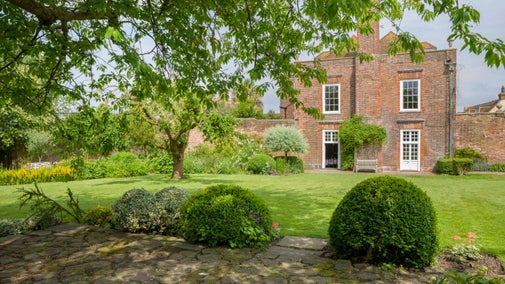
Donate
Everyone needs nature, now more than ever. Donate today and you could help people and nature to thrive at the places we care for.

Few gardens in England can boast such rich literary connections as the garden at Lamb House, which provided inspiration to both Henry James and E. F. Benson. Assistant Head Gardener Marr Mordaunt and his team have been bringing that muse back to life.
When Henry James acquired the tenancy at Lamb House, he began a programme of improvement to the house and garden. James felt he was ‘densely ignorant’ about gardens and plants, so he engaged his good friend and garden designer, Alfred Parsons, to develop the colourful flower borders and paths through the garden.
– Henry James
Parsons planted soft fruits such as apricots, plums, pears and apples up the walls and suggested planting mulberry and walnut trees. Henry James particularly enjoyed the daffodils in his garden every spring and was delighted when white Narcissus ‘Henry James’ was created in his honour.
We know that the produce grown by their gardener George Gammon was much prized, and we are influenced by what would have been grown in his time so we have continued to grow fruit, vegetables and cut flowers, and continue to bring the garden back to life.
The garden has been an inspiration to all who lived at Lamb House. It’s a beautiful and unexpected treat in the middle of Rye with a calm and peaceful atmosphere. It is the perfect place to relax, pick up a book and read.
We’ve been researching the history of the garden and, once this has been completed, it will help us with our future plans for the garden. In the meantime, we are busy improving the garden, making it presentable by getting rid of pernicious weeds, and improving the health of the plants that are there.
Our work over winter to renovate many of the trees, shrubs and climbing plants in the garden has paid dividends. The garden was filled with colour and fragrance while the roses were in bloom and now the wisteria is once again growing to fill the Garden Room wall and will, no doubt, reward us with a beautiful display when it flowers in spring.
In the summer, the herbaceous borders take centre stage and the flowering perennials will soon be joined by the summer annuals and dahlias to provide a lovely display right through until the autumn.
With your ongoing support, we're able to continue our vital conservation work. Thank you for helping to protect these special places.

Everyone needs nature, now more than ever. Donate today and you could help people and nature to thrive at the places we care for.

Discover an evocative garden tucked away behind the walls at Lamb House. It has an intimate, tranquil feel with borders packed full of flowers, a vegetable garden and shady trees.

Find out about this Georgian house and walled garden nestled in the heart of Rye. Discover the decades of inspiration it gave literary greats such as Henry James and E.F. Benson.

We believe that nature, beauty and history are for everyone. That’s why we’re supporting wildlife, protecting historic sites and more. Find out about our work.

Read about our strategy, which focuses on restoring nature, ending unequal access and inspiring more people.